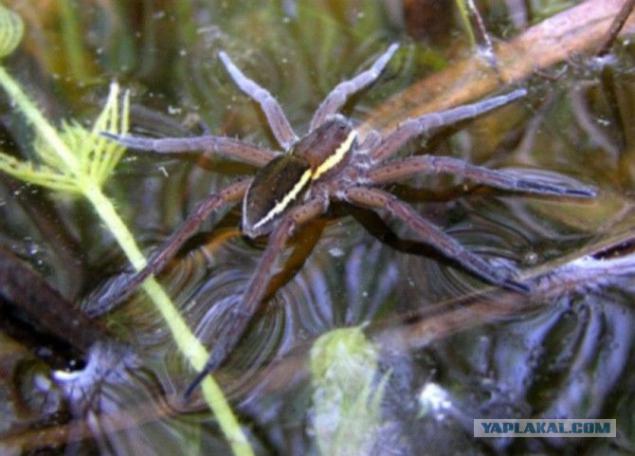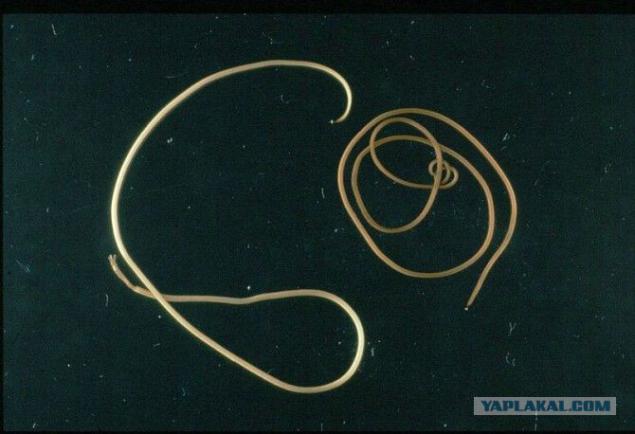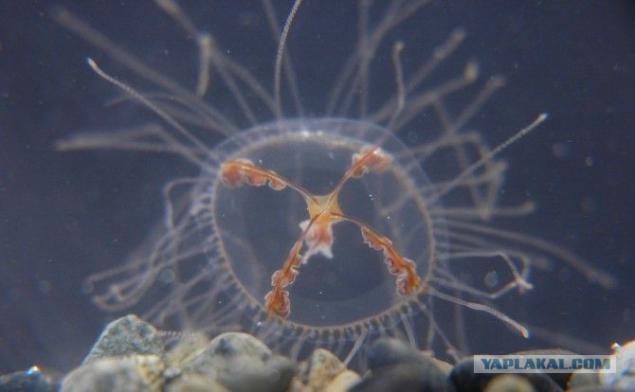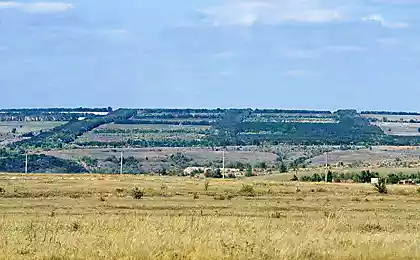1460
The most horrible inhabitants of Russian waters
"It is considered that only the southern tropical seas are full of dangerous human beings, and only there should be careful. However, in temperate climates meet Russian inhabitants of reservoirs, a meeting which should be avoided. One danger of a popular rumor attributes, and other really better not to meet.
Will 5 photos and some text.

PLANTARIUS
Great rafting Spider or Spider-hunter (Dolomedes plantarius), living on the banks of rivers, lakes and bogs in fact on the verge of extinction, so the meeting with him is unlikely. In Russia, the spread of Western-Palearctic species of this family of spiders, mostly living in the Samara region and Karelia. Size plantariusa females can reach 25 mm. Spiders hunters able to dive and move quickly through the water. Mainly they eat insects, but can attack fry and tadpoles. For a man plantariusa painful sting, the pain may persist for several weeks, but deadly to humans is not a spider.

Hair-
Popular rumor calls hair-living in the open waters of Russia, horsehair, came to life in the water and able to penetrate into the body, usually through the heel while swimming. Once under the skin, horse hair supposedly moving toward the heart, causing unbearable pain and itching of the skin. Pull it out of the body is considered to be impossible. In fact, for a man Nematomorpha completely harmless: these worms are actually parasites, but their home - insects. Hair-worm larvae, penetrating into the body of a large insect, developing there for about a month, and then turned into an adult, gnaw their way out. A man, even if he swallowed the larva with water during bathing, hair-will not bring harm, he just did not fit to live inside the human body. And certainly no danger are adults - Nematomorpha not eat anything and are not able to "chew" their digestive system is completely absent.
From myself, as a child frightened of each other this zhivotinku scary ... with mums and dads ... scared to swim without one child is not running ... but we still ran!

Gonionemus vertens
Poisonous jellyfish, living in Japan and Okhotsk seas, the waters of the Tatar Strait. The size of a small jellyfish: its dome diameter reaches 25-40 mm and resembles a bell with four red folds in the form of a cross, which is why the jellyfish and got his nickname. Araneus stinging cells located on the tentacles, which can exceed the size of the Medusa several times. Medusa-like Araneus well-heated water, prefer shallow waters, muddy places and coves overgrown with sea grass and algae. Hot and dry summers always helps to increase the number of jellyfish.
For a person encounter with a jellyfish-Araneus not lethal, but painful. Immediately after the bite a person feels a strong burning sensation as if the skin touched a red-hot iron. Then, the affected area is red, itch, rash, decreased skin sensitivity. Ten minutes later, general weakness, back pain and joint pain, oppression of breathing, uncontrolled choking cough, nausea. The person experiences intense thirst, numbness of limbs, even in severe cases may develop paralysis. Pressure drops, temperature increases. In addition, the poison gonionemus vertens acts on the nervous system: a person comes to emotional arousal. Especially dangerous poison for allergy sufferers - they may develop a faint and dizzy. In such cases, no medical care is necessary. If there are no pronounced symptoms, the burn should be washed with sea water or alcohol-containing liquid, to hide in the shade and drink plenty of fluids - it reduces the concentration of the poison in the body. As a rule, malaise lasts up to six days, but discomfort can persist for months.

MARINE Whelp
The most poisonous fish of the Black Sea, also known as a sea scorpion and snake, the gills and fins have spines with venom glands. Dragons often inhabit shallow water and in small coves with sand and silt. Lying at the bottom, waiting for their prey predator, are unmasked only the head and the dorsal fin of the fish. Hatchling is very difficult to see, you can step on it by accident. Thrust this fish rarely leads to death, but few deaths yet been fixed. In addition, the sea dragon venom causes severe swelling, necrosis of the affected area, and extremely painful. Perhaps the development of paralysis, respiratory and hemodynamic disorders. Against poison sea dragon has even developed a special vaccine. Place injection doctors recommend wash sea water or saline, to remove debris from the wound poisonous spines. This sea dragon can eat - most importantly, immediately cut off the poisonous spines of the fish.

SCORPIO
Scorpionfish Black Sea or the Black Sea Marine ruff, living in the Black Sea, Eastern Atlantic and the Mediterranean Sea, sometimes comes in the Sea of Azov. Usually it is found off the coast, and there is a chance coincidence with her face. Also, see this fish is extremely difficult, therefore, to prick the spines of her very easily. Spikes scorpionfish, washed ashore by waves can even pierce through light shoes. After the injection the poison begins to cause pain, sometimes so much that can develop painful shock and loss of consciousness. In addition, the poison scorpionfish greatly reduces the pressure, causing numbness and even can cause pulmonary edema. While deaths are rare, unpleasant symptoms may persist for several days. Pricks thorns scorpion dangerous for people with weakened hearts, their venom can cause inflammation of the heart muscle paralysis and death from respiratory failure
taken
everything!
you can not swim in places not designated for swimming!

Will 5 photos and some text.

PLANTARIUS
Great rafting Spider or Spider-hunter (Dolomedes plantarius), living on the banks of rivers, lakes and bogs in fact on the verge of extinction, so the meeting with him is unlikely. In Russia, the spread of Western-Palearctic species of this family of spiders, mostly living in the Samara region and Karelia. Size plantariusa females can reach 25 mm. Spiders hunters able to dive and move quickly through the water. Mainly they eat insects, but can attack fry and tadpoles. For a man plantariusa painful sting, the pain may persist for several weeks, but deadly to humans is not a spider.

Hair-
Popular rumor calls hair-living in the open waters of Russia, horsehair, came to life in the water and able to penetrate into the body, usually through the heel while swimming. Once under the skin, horse hair supposedly moving toward the heart, causing unbearable pain and itching of the skin. Pull it out of the body is considered to be impossible. In fact, for a man Nematomorpha completely harmless: these worms are actually parasites, but their home - insects. Hair-worm larvae, penetrating into the body of a large insect, developing there for about a month, and then turned into an adult, gnaw their way out. A man, even if he swallowed the larva with water during bathing, hair-will not bring harm, he just did not fit to live inside the human body. And certainly no danger are adults - Nematomorpha not eat anything and are not able to "chew" their digestive system is completely absent.
From myself, as a child frightened of each other this zhivotinku scary ... with mums and dads ... scared to swim without one child is not running ... but we still ran!

Gonionemus vertens
Poisonous jellyfish, living in Japan and Okhotsk seas, the waters of the Tatar Strait. The size of a small jellyfish: its dome diameter reaches 25-40 mm and resembles a bell with four red folds in the form of a cross, which is why the jellyfish and got his nickname. Araneus stinging cells located on the tentacles, which can exceed the size of the Medusa several times. Medusa-like Araneus well-heated water, prefer shallow waters, muddy places and coves overgrown with sea grass and algae. Hot and dry summers always helps to increase the number of jellyfish.
For a person encounter with a jellyfish-Araneus not lethal, but painful. Immediately after the bite a person feels a strong burning sensation as if the skin touched a red-hot iron. Then, the affected area is red, itch, rash, decreased skin sensitivity. Ten minutes later, general weakness, back pain and joint pain, oppression of breathing, uncontrolled choking cough, nausea. The person experiences intense thirst, numbness of limbs, even in severe cases may develop paralysis. Pressure drops, temperature increases. In addition, the poison gonionemus vertens acts on the nervous system: a person comes to emotional arousal. Especially dangerous poison for allergy sufferers - they may develop a faint and dizzy. In such cases, no medical care is necessary. If there are no pronounced symptoms, the burn should be washed with sea water or alcohol-containing liquid, to hide in the shade and drink plenty of fluids - it reduces the concentration of the poison in the body. As a rule, malaise lasts up to six days, but discomfort can persist for months.

MARINE Whelp
The most poisonous fish of the Black Sea, also known as a sea scorpion and snake, the gills and fins have spines with venom glands. Dragons often inhabit shallow water and in small coves with sand and silt. Lying at the bottom, waiting for their prey predator, are unmasked only the head and the dorsal fin of the fish. Hatchling is very difficult to see, you can step on it by accident. Thrust this fish rarely leads to death, but few deaths yet been fixed. In addition, the sea dragon venom causes severe swelling, necrosis of the affected area, and extremely painful. Perhaps the development of paralysis, respiratory and hemodynamic disorders. Against poison sea dragon has even developed a special vaccine. Place injection doctors recommend wash sea water or saline, to remove debris from the wound poisonous spines. This sea dragon can eat - most importantly, immediately cut off the poisonous spines of the fish.

SCORPIO
Scorpionfish Black Sea or the Black Sea Marine ruff, living in the Black Sea, Eastern Atlantic and the Mediterranean Sea, sometimes comes in the Sea of Azov. Usually it is found off the coast, and there is a chance coincidence with her face. Also, see this fish is extremely difficult, therefore, to prick the spines of her very easily. Spikes scorpionfish, washed ashore by waves can even pierce through light shoes. After the injection the poison begins to cause pain, sometimes so much that can develop painful shock and loss of consciousness. In addition, the poison scorpionfish greatly reduces the pressure, causing numbness and even can cause pulmonary edema. While deaths are rare, unpleasant symptoms may persist for several days. Pricks thorns scorpion dangerous for people with weakened hearts, their venom can cause inflammation of the heart muscle paralysis and death from respiratory failure
taken
everything!
you can not swim in places not designated for swimming!






















